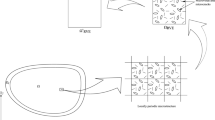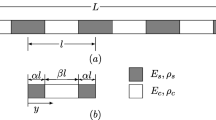Abstract
The integral-differential governing equation gives peridynamics an advantage in conducting homogenization analysis that involves defects. The purpose of this research is to provide a novel homogenization modeling approach that utilizes ordinary state-based peridynamics to predict the elastic properties of periodic microstructures. The periodic boundary conditions are applied by coupling the displacement of prebuilt point pairs. Peridynamic differential operator is employed to determine the displacement gradient and stress field. And the volume average method is used to obtain the effective elastic properties. The present study introduces a new approach for determining the effective properties of micro-structured materials featuring defects in a periodic configuration.
Graphical abstract












Similar content being viewed by others
References
Pindera M, Khatam H, Drago A et al (2009) Micromechanics of spatially uniform heterogeneous media: a critical review and emerging approaches. Compos Part B Eng 40:349–378
Zhao Y, Zhou Y, Hunag Z et al (2019) Experimental and micromechanical investigation of T300/7901 unidirectional composite strength. Polym Compos 40(7):2639–2652
Cheng H, Gao J, Kafka O et al (2017) A micro-scale cutting model for UD CFRP composites with thermo-mechanical coupling. Compos Sci Technol 153(1):18–31
Suquet P (1987) Elements of homogenization theory for inelastic solid mechanics, in homogenization techniques for composite media. Lect Note Phys 272:193–279
Paley M, Aboudi J (1992) Micromechanical analysis of composites by the generalized cells model. Mech Mater 14(2):127–139
Williams T (2005) A two-dimensional, higher-order, elasticity-based micromechanics model. Int J Solids Struct 42(3–4):1009–1038
Yu W, Tang T (2007) Variational asymptotic method for unit cell homogenization of periodically heterogeneous materials. Int J Solids Struct 44(11–12):3738–3755
Kobayashi M, Nikbay M (2013) On a Fourier spectral variational asymptotic method for cellular composite structures. In: 54th AIAA/ASME/ASCE/AHS/ASC structures, structural dynamics, and materials conference
Silling S, Askari E (2005) A meshfree method based on the peridynamic model of solid mechanics. Compos Struct 83(17–18):1526–1535
Shi C, Shi Q, Tong Q et al (2021) Peridynamics modeling and simulation of meso-scale fracture in recycled coarse aggregate (RCA) concretes. Theor Appl Fract Mech 114:102949
Hou D, Zhang W, Wang P et al (2021) Mesoscale insights on the structure, mechanical performances and the damage process of calcium–silicate–hydrate. Constr Build Mater 287:123031
Wang Y, Zhou X, Zhang T (2019) Size effect of thermal shock crack patterns in ceramics: insights from a nonlocal numerical approach. Mech Mater 137:103133
Hu Y, Yu Y, Madenci E (2020) Peridynamic modeling of composite laminates with material coupling and transverse shear deformation. Compos Struct 253:112760
Tian D, Zhou X (2021) A continuum-kinematics-inspired peridynamic model of anisotropic continua: elasticity, damage, and fracture. Int J Mech Sci 199:106413
Qi J, Li C, Tie Y et al (2022) An ordinary state-based peridynamic computational investigation of fiber-reinforced composites. Comp Part Mech 10(4):777–791
Madenci E, Barut A, Phan N (2018) Peridynamic unit cell homogenization for thermoelastic properties of heterogenous microstructures with defects. Compos Struct 188:104–115
Madenci E, Yaghoobi A, Barut A et al (2020) Peridynamic unit cell for effective properties of complex microstructures with and without defects. Theor Appl Fract Mech 110:102835
Hu Y, Wang J, Madenci E et al (2022) Peridynamic micromechanical model for damage mechanisms in composites. Compos Struct 301:116182
Li X, Yu Y, Mu Z et al (2021) Meso-scale modeling for effective properties in continuous fiber-reinforced composites by state-based peridynamics. Acta Mech Solida Sin 34:729–742
Hu Y, Madenci E (2016) Bond-based peridynamic modeling of composite laminates with arbitrary fiber orientation and stacking sequence. Compos Struct 153:139–175
Xia W, Oterkus E, Oterkus S (2021) Ordinary state-based peridynamic homogenization of periodic micro-structured materials. Theor Appl Fract Mech 113:102960
Xia W, Oterkus E, Oterkus S (2020) Peridynamic modelling of periodic microstructured materials. Procedia Struct Integr 28:820–828
Madenci E, Barut A, Futch M (2016) Peridynamic differential operator and its applications. Comput Methods Appl Mech Eng 304(1):408–451
Shojaei A, Galvanetto U, Rabczuk T et al (2019) A generalized finite difference method based on the peridynamic differential operator for the solution of problems in bounded and unbounded domains. Comput Method Appl Mech Eng 343:100–126
Li Z, Huang D, Xu Y et al (2020) Nonlocal steady-state thermoelastic analysis of functionally graded materials by using peridynamic differential operator. Appl Math Model 93:294–313
Haghighat E, Bekar A, Madenci E et al (2021) A nonlocal physics-informed deep learning framework using the peridynamic differential operator. Comput Method Appl Mech Eng 385:114012
Dorduncu M, Apalak M (2020) Elastic flexural analysis of adhesively bonded similar and dissimilar beams using refined zigzag theory and peridynamic differential operator. Int J Adhes Adhes 101:102631
Madenci E, Oterkus E (2014) Peridynamic theory and its applications. Springer, New York
Kilic B, Madenci E (2010) An adaptive dynamic relaxation method for quasi-static simulations using the peridynamic theory. Theor Appl Fract Mech 53(3):194–204
Zhang H, Qiao P (2018) An extended state-based peridynamic model for damage growth prediction of bimaterial structures under thermomechanical loading. Eng Fract Mech 189:81–97
Wang F, Liu L, Liu Q (2015) Studies of bimaterial interface fracture with peridynamics, In: Proceedings of the 2015 international power, electronics and materials engineering conference. Atlantis Press, pp 856–861
Nguyen H, Wang H, Tanaka S et al (2022) An in-depth investigation of bimaterial interface modeling using ordinary state-based peridynamics. J Peridyn Nonlocal Model 4:112–138
Gu X, Madenci E, Zhang Q (2018) Revisit of non-ordinary state-based peridynamics. Eng Fract Mech 190:31–52
Cioranescu D, Donato P (1999) An introduction to homogenization. Oxford University Press, Oxford, p 17
Mori T, Tanaka K (1973) Average stress in matrix and average elastic energy of materials with misfitting inclusions. Acta Metal 21(5):571–574
Hu Y (2017) Peridynamic modeling of fiber-reinforced composites with polymer and ceramic matrix. University of Arizona
Markenscoff X, Dascalu C (2012) Asymptotic homogenization analysis for damage amplification due to singular interaction of micro-cracks. J Mech Phys Solids 60:1478–1485
Li J, Wang Q, Li X et al (2022) Homogenization of periodic microstructure based on representative volume element using improved bond-based peridynamics. Eng Anal Bound Elem 143:152–162
Sun C, Vaidya R (1996) Prediction of composite properties from a representative volume element. Compos Sci Technol 56(2):171–179
Aboudi J, Pindera M, Arnold S (2003) Linear thermoelastic higher-order theory for periodic multiphase materials. Int J Plast 19:805–847
Sun C, Chen J (1991) A micromechanical model for plastic behavior of fibrous composites. Compos Sci Technol 40:115–129
Chamis C (1984) Simplified composite micromechanics equations for hygral, thermal and mechanical properties. SAMPE Q 4:14–23
Kenaga D, Doyle J, Sun C (1987) The characterization of boron/aluminum composite in the nonlinear range as an orthotropic elastic–plastic material. J Compos Mater 27:516–531
Hashin Z, Rosen B (1964) The elastic moduli of fiber-reinforced materials. ASME J Appl Mech 31:223–232
Galadima Y, Xia W, Oterkus E (2023) A computational homogenization framework for non-ordinary state-based peridynamics. Eng Comput 39:461–487
Acknowledgements
The research work was supported by the National Natural Science Foundations of China (No. U1833116 and 11402234 and 52175153).
Author information
Authors and Affiliations
Corresponding authors
Ethics declarations
Conflict of interest
No competing financial interests or personal relationships that could have influenced the work reported in this paper.
Additional information
Publisher's Note
Springer Nature remains neutral with regard to jurisdictional claims in published maps and institutional affiliations.
Rights and permissions
Springer Nature or its licensor (e.g. a society or other partner) holds exclusive rights to this article under a publishing agreement with the author(s) or other rightsholder(s); author self-archiving of the accepted manuscript version of this article is solely governed by the terms of such publishing agreement and applicable law.
About this article
Cite this article
Qi, J., Li, C., Tie, Y. et al. A peridynamic-based homogenization method to compute effective properties of periodic microstructure. Comp. Part. Mech. (2024). https://doi.org/10.1007/s40571-023-00698-4
Received:
Revised:
Accepted:
Published:
DOI: https://doi.org/10.1007/s40571-023-00698-4




